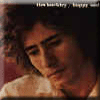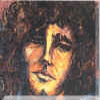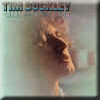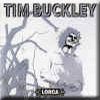Tim
Buckley: A Discographic Primer by
Wilson Neate Artists
who die young tend to become frozen in myth,
often because their recorded legacy is small and relatively homogenous, leaving
fans to wonder what they would have become. Tim Buckley died at 28 but his story
is slightly different from that of, say, Nick Drake or his own late son, Jeff.
Lasting less than nine years, his commercially unsuccessful recording career was
brief but productive: he managed nine studio albums, plus enough material for
numerous posthumous releases. The immense diversity of his work makes it hard
to categorize in simple terms — and even harder to imagine the direction
(or directions) he might have pursued. Along
with Orange County, California, contemporaries Jackson Browne and Steve Noonan,
Buckley signed to Elektra in the mid-'60s. Although he was perceived as a coffeehouse
folk singer-songwriter (as was anyone who strummed an acoustic guitar and didn't
do pop covers in those days), that scarcely describes him.Buckley's
1966 debut album was already shot through with electricity and displayed flashes
of psychedelia; by 1968, he had embraced a jazzier vibe that looked beyond straightforward
song structures. Nevertheless, he wasn't content with just pushing artistic boundaries;
rather, he crossed them to explore more difficult avant-garde territory, quickly
leaving fans and commercial viability behind. In
the process he transformed his rich tenor, which had captivated audiences, into
a fierce wailing instrument and dropped his laid back ballads in favor of dissonance
and rhythmic complexity. Even more surprisingly, Buckley ultimately reinvented
himself as a strutting barroom rocker, pumping out gloriously sleazy white funk. Buckley
recorded his eponymous debut in his teens. Not surprisingly, it's by no means
a mature work, and he doesn't sound entirely comfortable amid the arrangements
and production, which are emblematic of Los Angeles in the mid-'60s. Still, this
record does indicate Buckley's enormous potential. Over half the tracks were co-written
by high-school friend Larry Beckett, who has a weakness for awkward, mannered
lyrics. On She Is, for instance, Buckley's sublime voice belies his youth,
but fey pseudo-poetry like A mischief mystery she plays upon the flute of early
morn does him no favors. Although
often excessively romantic, Buckley's own songs are superior, especially Aren't
You the Girl, It Happens Every Time (with a sweeping string arrangement by
Jack Nitzsche) and Wings, a big symphonic pop number that was certainly
hit single material. One of the co-written tracks — the smoldering, psychedelic
Song Slowly Song, with delicate guitar courtesy of Lee Underwood — anticipates
the less conventional musical structures Buckley would later explore. Recorded
in summer of 1967, with Jerry Yester producing, Goodbye and Hello was a
considerable step forward for Buckley. While it shares some of the debut's preciousness,
it's less one-dimensional and more ambitious. This doesn't always work. The psychedelic
touches are more pronounced, and there's a tendency to incorporate Elizabethan
motifs, but over-produced numbers like the title track or Hallucinations
don't fare too well. Beckett
co-wrote five of the ten songs, including the stirring protest No Man Can Find
the War, but the more memorable tracks are again Buckley's own. They show
him growing, finding his own voice and developing a highly personal vision (particularly
Pleasant Street, Once I Was and Phantasmagoria in Two). The standout
is I Never Asked to Be Your Mountain, an intense epic of competing rhythms
fueled by Carter CC Collins on congas. The lyrics might be melodramatic and juvenile,
but Buckley pushes his five-and-a-half octave range to the limit, and that makes
it work. (The song makes passing reference to his son, who eventually performed
it in 1991 at a tribute concert in New York.) Although
Goodbye and Hello captured the counter-cultural zeitgeist with its anti-establishment
sentiments and psychedelic feel, Buckley quickly distanced himself from that scene
and balked at suggestions that he might speak for a generation or catalyze political
change with his records. Disillusioned with rock and the music business, Buckley
opted to follow his own creative instincts. He and guitarist Underwood gravitated
toward jazz, listening to Mingus, Miles and Monk, artists whose influence declared
its presence on the near-perfect Happy Sad. Echoes of Davis' All Blues
are unmistakable on the lilting Strange Feelin', and vibes player David Friedman
jokingly labeled the band on this release the Modern Jazz Quartet of Folk.  |
Jerry
Yester, who overproduced parts of Goodbye and Hello, shared the job with
Zal Yanovsky of the Lovin' Spoonful, and gets the balance right on Happy Sad.
It would have been hard to go wrong with this material. Buckley composed all six
songs, evidence of a newfound maturity, alone. In keeping with its title, this
is very much an album of moods. Apart from the ecstatic, twelve-minute Gypsy
Woman, Happy Sad focuses on the mellower, introspective end of the
emotional spectrum. The
only electric instrument here is Underwood's quietly intense guitar, which, along
with Friedman's vibes, adds tone and coloring (for instance, on the atmospheric
epic Love From Room 109 at the Islander and the yearning Buzzin' Fly).
Happy Sad reached the Top 100, capping his albums' chart success.  |
Works
in Progress, a collection
of previously unreleased sessions from 1968, documents Buckley's
evolution from Goodbye and Hello to Happy Sad. Dream Letter: Live in
London 1968 is a superb two-hour live set from that transitional period, recorded
with Friedman, Underwood and Pentangle bassist Danny Thompson. Full-band workouts
of Morning Glory and Fred Neil's Dolphins are outstanding, but solo
performances by Buckley and his twelve-string steal the show; Wayfaring Stranger
and a rendition of Pleasant Street segueing into You Keep Me Hanging
On are truly spine-tingling. Further recordings from 1968 appear on 1991's
Peel Sessions EP, which was later reissued with additional material on
both Morning Glory and Once I Was.Buckley
produced Blue Afternoon himself, continuing in the melodic folk-jazz vein
of Happy Sad with the same players, plus drummer Jimmy Madison. Strictly
speaking, however, this was not Buckley's next album. He had already recorded
Lorca for Elektra and was due to record an album for the Straight label,
which had been set up by his manager, Herb Cohen, and Frank Zappa. Based on what
Cohen had heard of the direction taken on Lorca (he produced the album
with Beefheart/Mothers of Invention engineer Dick Kunc), he was concerned about
the commercial potential of Buckley's debut for Straight and asked him to record
something more in the spirit of his earlier work.  |
Buckley's
heart wasn't really in it as he had already set off on a new creative path with
Lorca but he complied, quickly recording songs he had already written and
worked on in sessions but had not committed to vinyl. Remarkably, some of these
tracks, which Buckley had pretty much discarded, rank among his finest: Chase
the Blues Away and Happy Time (both of which also appear on Works
in Progress), Blue Melody, I Must Have Been Blind and The River. These
epitomize Buckley's aptitude for taking the folk song as a departure point and
expanding it, infusing it with elements of jazz to explore new dynamics, stressing
mood and atmosphere. |
After
the detour of Blue Afternoon, Buckley returned to the experimentation already
underway. Blue Afternoon was released to a largely indifferent reaction.
Lorca followed shortly thereafter. If, as Debbie Burr commented in Creem
at the time, Blue Afternoon [is] not even good sulking music, then the
five-track Lorca certainly gave folks something to cry about. Driftin'
and Nobody Walkin' show some continuity with Happy Sad and Blue
Afternoon, but the album isn't remembered for those songs, if it's remembered
at all. The
dark, brooding title track, which began Lorca, marked Buckley's most dramatic
shift yet. He had often emphasized the importance of vocals as an overlooked instrument
and focused on that aspect of his music for Lorca. The voice of mezzo-soprano
Cathy Berberian on electronic works by Luciano Berio had impressed Buckley and
Lorca displays kinship with her technique. Buckley's previous records had attested
to his range and his ability to hold notes, but Lorca was an attempt to
produce something like Berberian's highly idiosyncratic vocalese, with an unsettling
acrobatic performance that eventually went beyond language into wordless shrieks,
wails and vibrato crooning up and down the scales. Moreover,
the accompanying avant-garde jazz arrangement in 5/4 time (with pipe organ and
electric piano by bassist John Balkin and Underwood respectively) showed little
interest in tunefulness. The absence of a comforting song structure only made
it all the more uneasy for fans expecting something along the lines of Blue
Melody. The album, a critical and commercial failure, was Buckley's final
release on Elektra. 1994's
Live at the Troubadour 1969 captures Buckley in performance
around the time
of Blue Afternoon and Lorca and draws songs primarily from those
two albums and Happy Sad. Listened to alongside Dream Letter, the
live album recorded less than a year earlier, it dramatically underscores the
changes in Buckley's sound. While epic, unbridled renditions of Gypsy Woman
and Nobody Walkin' offer excellent examples of a more improvisational
approach, Strange Feelin' is a distant, far bluesier cousin of the version
on Dream Letter. Despite
Lorca's poor reception, Buckley pressed on with Starsailor, a record
that drew inspiration from contemporary classical composers like Messiaen, Penderecki
and Stockhausen as well as avant-garde jazz. Buckley self-produced his most uncompromising
album, a work of genius or folly (or perhaps both) that provokes sharply divided
reaction. Buckley expanded his instrumental arsenal with Maury Baker on tympani
and Mothers of Invention horn players Bunk Gardner (tenor sax and alto flute)
and Buzz Gardner (trumpet, flugelhorn). Sustained
melodies and songs aren't a priority here — the more challenging arrangements
are fragmented
and dissonant, set in unusual time signatures. Although Buckley had proven himself
as a lyricist with a distinctive introspective vision, Starsailor makes
it abundantly clear that he felt words weren't necessary to communicate. He often
forsakes conventional language for glossolalia, conveying a gamut of emotions
— from anguish to euphoria and everything in between, sometimes leaping from
one end of the emotional register to the other. The eerily hypnotic a cappella
title track features Buckley alone — with fifteen overdubbed tracks of his
voice.Elsewhere
on Starsailor, freeform pieces like The Healing Festival (in 10/4
time) and Jungle Fire (in 5/4) at times give the impression that each musician
is playing a different song on a different planet, albeit with absolute control
and precision. If Starsailor has any parallels in rock, Captain Beefheart's
Trout Mask Replica would be one — especially in its rigorously disciplined
madness. While Monterey threatens to become a rock song but never quite
coalesces as such, there are some conventional moments, one of which provides
the album's highlight: the ethereal Song to the Siren, the track for which
Buckley is best known thanks to a 1983 cover by the Cocteau Twins as part of This
Mortal Coil. (Even Pat Boone recorded the song in 1968, before Buckley himself
had released it.) When
he next returned to the studio, in 1972 for Greetings From LA, Buckley
bit the bullet,
playing the conventional mainstream fare being demanded of him. If it's true that
he felt frustrated by what he saw as the limitations of rock'n'roll with its clichés
and formulas, and that he was unhappy with his new identity, it doesn't show on
this album. Far from it, in fact. Backed by a new band (except for Carter Collins),
Buckley sounds completely at home, stretching easily from swampy blues to straight-ahead
rock, injecting a generous dose of funk into the proceedings.  |
Both musically and lyrically, this is an orgy of a record, dripping with sweat
and sex, and Buckley — whose sense of humor is fully evident for the first
time here — throws himself headlong into it. With its conventional rock songs,
there's nothing innovative about Greetings From LA. Even so, Buckley's
character is all over it. His impressive vocal range is still obvious on the opening
triad of Move With Me, Get on Top and Sweet Surrender, as well as
on the string-washed finale, Make It Right. These tracks are light years
from the abstractions of Starsailor, whose wailing and moaning suggested
a pre-Oedipal, cosmic sexuality — this one is much earthier. (Buckley called
this album a response to the likes of Mick Jagger, who sang about sex without
ever saying anything sexy.) Buckley
may have sung in tongues on Starsailor, but Get on Top puts a different
twist on the concept: Get
on top of me woman
Let me see what you learned tonight
Then I talk in
tongues mama
Oh when I love you
Yes I talk in tongues.
Instead of flute of early morn and 'O whither has my lady wandered'?, Get
on Top offers Like a bitch dog in heat we had those bed springs a squeakin'
all day long. In Make It Right, he's looking for a street-corner girl and
implores Come
on and beat me, whip me, spank me. The
radio-friendly Sefronia was cut from similar cloth. Numbers like Honey
Man and Stone in Love provided additional evidence of Buckley's new
identity as funk-rock sack master, but the record is weaker than its predecessor.
Denny Randell's anachronistic-on-impact LA white-soul production, which pours
syrupy strings over several numbers, is hardest to digest on poorly chosen middle-of-the-road
love songs that didn't suit Buckley at all: a sentimental rendition of Tom Waits'
Martha and a cloying duet with Marcia Waldorf, I Know I'd Recognize
Your Face. The genuinely soulful ballad Because of You and a stellar
version of Dolphins (featuring Lee Underwood's only appearance on the album)
do compensate somewhat but, overall, this is a bland affair.Demos
of Sefronia songs — some of which didn't make that album — are
on the posthumous Dream Belongs to Me, which also features a handful of
1968 demos that appeared on Works in Progress. Broadcast
live as a radio session in 1973 and released in 1995, Honeyman draws largely
from Greetings and Sefronia. While he might have been declining
on record, Buckley was still absolutely fine live. This album would stand as a
respectable epitaph, were it not for Look at the Fool, which ended Buckley's
career on an inglorious note. Although the title track and Who Could Deny You
stand up reasonably well, the rest sounds burned out and is best forgotten, especially
the dreadful Louie Louie rip-off, Wanda Lu. Surprisingly,
it took until 2001 for a Tim Buckley retrospective CD to be assembled.
The two-disc Morning Glory reflects the struggle between Buckley's artistic
goals and commercial pressures. Two dozen of the set's 33 tracks date from the
period covered by the first four records. There's only a live version of one song
from Lorca, and Starsailor is represented by its three most accessible
numbers (including two versions of Song to the Siren).
By privileging material from the less challenging wandering-troubadour and folk-jazz
periods, this collection once again suppresses the material in which Buckley was
most invested, and for which he tragically failed to find an audience during his
lifetime, which ended in 1975. Used
with Permission
©
Neate/Trouser Press
Trouser
Press was a rock and roll magazine started in New York in 1974 as a mimeographed
fanzine by editor/publisher Ira Robbins, fellow Who fan Dave Schulps and Karen
Rose under the name "Trans-Oceanic Trouser Press". Robbins ceased publication
after the April 1984 issue. TrouserPress.com
went online in August 2002. |